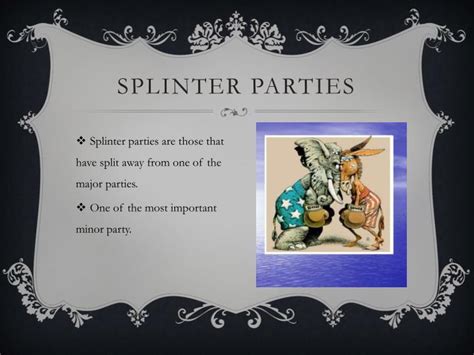Definition
In American political science, a splinter party is a minor political party that emerges from a larger, established party due to ideological differences or conflicts over leadership. These parties typically form when a significant group within the mainstream party feels that its views are not adequately represented or addressed.

Causes of Splinter Parties
The creation of splinter parties is often driven by the following factors:
- Ideological Discord: Disagreements over core principles or policies can lead to the formation of splinter parties as members seek an alternative political outlet that more closely aligns with their beliefs.
- Leadership Disputes: Personal conflicts or disagreements over party leadership can motivate individuals to break away and create new organizations.
- Electoral Disappointment: Poor electoral performance or frustration with the mainstream party’s strategy can lead to the formation of splinter groups that hope to capitalize on unfulfilled voter expectations.
- External Pressure: Changes in the political landscape, such as the emergence of new social movements or shifts in public opinion, can create opportunities for splinter parties to gain support.
Impact of Splinter Parties
The presence of splinter parties can have significant impacts on the political system:
- Fragmentation of the Political Spectrum: Splinter parties can lead to a more fragmented political landscape, with votes spread across multiple minor parties instead of being concentrated in a few major ones.
- Increased Competition: Splinter parties introduce additional competition into the electoral process, potentially making it more difficult for larger parties to secure decisive victories.
- Challenge to the Two-Party System: Splinter parties can challenge the dominance of the two major parties, offering voters alternative choices and potentially shaking up the political establishment.
- Influence on Policy Outcomes: Depending on their level of support, splinter parties can influence policy decisions by bringing attention to specific issues or by aligning with larger parties on particular legislation.
Notable Examples of Splinter Parties
Throughout American history, several notable splinter parties have emerged:
| Party | Year Formed | Ideology |
|---|---|---|
| Free Soil Party | 1848 | Anti-slavery |
| Populist Party | 1891 | Agrarian populism |
| Progressive Party | 1912 | Reform and social justice |
| American Independent Party | 1968 | Conservative |
| Libertarian Party | 1971 | Libertarianism |
Benefits of Splinter Parties
While splinter parties can pose challenges to the political system, they can also offer certain benefits:
- Increased Political Participation: Splinter parties provide an entry point for individuals who feel underserved by the mainstream parties, increasing political engagement and representation.
- Diversity of Thought: Splinter parties represent a broader range of political perspectives, encouraging greater debate and policy innovation.
- Pressure for Reform: The presence of splinter parties can exert pressure on larger parties to address issues or adopt policies that respond to the concerns of marginalized groups.
Common Mistakes to Avoid
Individuals considering forming or supporting a splinter party should avoid common mistakes such as:
- Lack of Clear Ideological Platform: Splinter parties must have a clearly defined ideological platform that differentiates them from other parties and resonates with potential voters.
- Short-Sighted Leadership: Effective splinter parties require strong leadership that can articulate their vision, build support, and navigate political challenges.
- Excessive Electoral Ambition: Splinter parties should focus on establishing a solid foundation and building grassroots support before seeking electoral victories.
- Infighting and Division: Internal conflicts and divisions can erode a splinter party’s credibility and support.
Why Splinter Parties Matter
Splinter parties play a significant role in the American political system by:
- Representing marginalized voices and promoting diversity of thought
- Challenging the status quo and encouraging political innovation
- Serving as a barometer of public sentiment and dissatisfaction
- Shaping policy outcomes and influencing electoral dynamics
Conclusion
Splinter parties are an integral part of the American political landscape. They emerge from ideological and leadership divisions, and their presence can both challenge and enrich the political system. Understanding the causes, impact, and benefits of splinter parties is crucial for comprehending the complexities of American politics. As the political landscape continues to evolve, splinter parties will undoubtedly continue to play a role in shaping the nation’s future.
